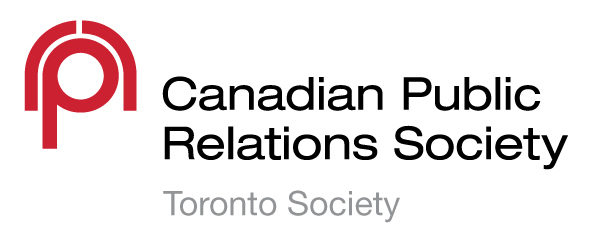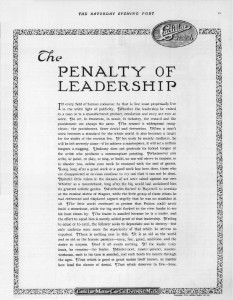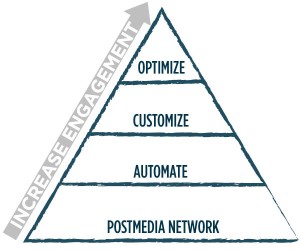The year: 1915. The publication: The Saturday Evening Post, one of the most influential and widely read U.S. magazines of the early 20th century. The advertiser: the Cadillac Motor Car Co., which at the time had only been in existence for a little more than a decade. The problem: a competitor, Packard Motors, was starting to make inroads into the expanding luxury automobile market.
The solution: the world’s first native advertisement.
The ad was titled The Penalty of Leadership and its flowery prose – written very much in the elaborate and ornate style of the day – never mentioned the word Cadillac once. Instead, in a very subtle way, it made the point that those in a position of leadership (i.e. Cadillac) would always be attacked by those who would never be able to lead (i.e Packard).
The leader is assailed because he is a leader, and the effort to equal him is merely added proof of that leadership. Failing to equal or to excel, the follower seeks to depreciate and to destroy – but only confirms once more the superiority of that which he strives to supplant.
No one used the term thought leadership in 1915. But looking through a historical lens, that’s exactly what Cadillac was selling a century ago. Today, the very best native advertising uses more elaborate means of promoting thought leadership, raising brand awareness or advancing ideas.
If executed intelligently, native advertising can truly engage a skeptical and sophisticated consumer.
At Postmedia, when we work with clients on an effective native advertising campaign, we visualize an engagement process that’s built like a pyramid.
At the base of the pyramid is traditional print and display advertising. It’s still the core of any successful campaign and when ads are created to complement native content, we’ve seen reader engagement and CTRs triple and quadruple industry standard.
The next layer of the pyramid is our Native Network, an automated process that allows us to distribute the native content across all Postmedia properties in an efficient and scalable way.
Then we move to the customized layer, which is where Postmedia Works, our commercial content studio, works with brands and agencies to create authentic and engaging content by helping clients determine the best story to tell.
Finally, at the top of the pyramid is optimization. We take the native content and amplify it across social networks – Facebook, Twitter and LinkedIn – so it’s aimed at the client’s specific target demographic. Then we measure and analyse the performance and make adjustments as necessary to enhance engagement.
This multi-pronged approach has resulted in some tremendous campaigns for many Postmedia clients, like Fairmont Hotels and Concordia University.
Click here to register for our upcoming private session on Wednesday, July 29th to learn more about Postmedia Content Solutions.
We’ll provide further insight into how public relations agencies can benefit from our native network and custom content opportunities.
For more information visit postmediacontentsolutions.com
Scott White is Vice-President of Content Strategy & Business Development for Postmedia Network. Prior to joining Postmedia, he was Editor-in-Chief of The Canadian Press, Canada’s national news agency.


